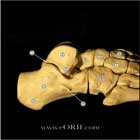 |
synonyms: Astragalus fracture, talar body fracture, talar fracture, Talus Fracture ICD-10
A- initial encounter for closed fracture B- initial encounter for open fracture D- subsequent encounter for fracture with routine healing G- subsequent encounter for fracture with delayed healing K- subsequent encounter for fracture with nonunion P- subsequent encounter for fracture with malunion S- sequela
Talar Body Fracture Etiology / Epidemiology / Natural History
Talar Body Fracture Clinical Evaluation
Talar Body Fracture Classification / Treatment
Talar Body Fracture Associated Injuries Talar Body Fracture Complications Talar Body Fracture Follow-Up care
cc |
